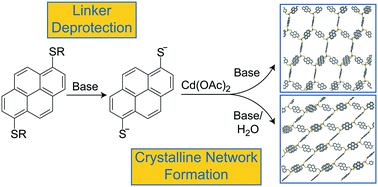Designing crystalline, flexible covalent metal–organic networks through controlled ligand deprotection
Abstract
A strategy to generate crystalline coordination polymers with strong, covalent metal-linker bonds is presented. 1,6-Pyrenedi(2-ethylhexylmercaptopropionate) (1) is converted to 1,6-pyrenedithiolate (PDT) via a base-mediated deprotection allowing for rate control of the metal-linker self assembly. This leads to the formation of a single-crystalline, flexible 2D coordination polymer, [Cd(PDT)2][Cd(en)3] (3).



 Please wait while we load your content...
Please wait while we load your content...